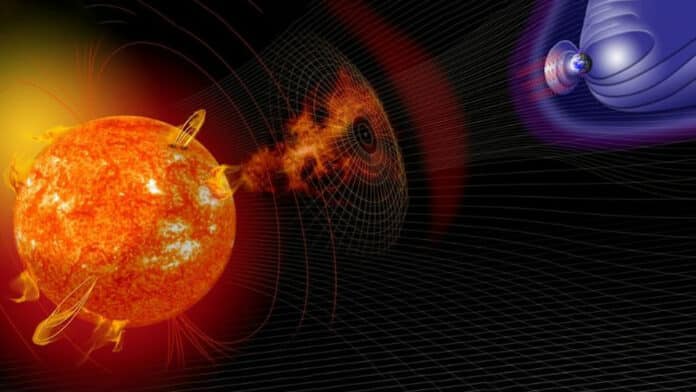A team of researchers from the Collège de France, CEREGE, IMBE, Aix-Marseille University, and the University of Leeds reveals new insights into the Sun’s extreme behavior and its risks to Earth. Researchers measured radiocarbon levels in ancient trees preserved within the eroded banks of the Drouzet River near Gap in the Southern French Alps.
The radiocarbon method is widely used to date fossil samples over the last 55,000 years. It is based on the radioactive decay of a chemical element produced in the upper atmosphere by interaction with cosmic ray particles.
The tree trunks, incompletely fossilized remains known as subfossils, were cut into tiny single tree rings. The examination of these rings revealed a rare radiocarbon level that occurred precisely 14,300 years ago. The research suggests that the radiocarbon spike was caused by a powerful solar storm that would have expelled enormous quantities of energetic particles into Earth‘s atmosphere by comparing measurements of beryllium, a chemical element present in Greenland ice cores, with the radiocarbon increase.
This radiocarbon spike is the biggest ever identified. A similar solar storm today would be disastrous for our highly advanced society, perhaps destroying satellite and telecommunication networks, resulting in widespread blackouts of the energy grid and costing us billions of pounds.
Understanding the possible hazards of future occurrences like this is essential because it will help us prepare, strengthen the resilience of our energy and communications networks, and protect them from damage.
Nine powerful solar storms, also known as Miyake Events, have been counted over the past 15,000 years. The most recent verified Miyake Events occurred in 774 and 993 AD, respectively. However, this newly discovered 14,300-year-old storm is the biggest and is approximately twice as massive as these two.
Since these Miyake Events have never been directly detected with an instrument, their exact nature is still poorly understood. They emphasize that there is still a lot we need to learn more about the Sun’s behavior and the risks it poses to human culture. We have yet to know why such powerful solar storms happen, how frequently they might happen, or whether we can foresee them.
Edouard Bard, Professor of Climate and Ocean Evolution at the Collège de France and CEREGE and lead author of the study, said, “Direct instrumental measurements of solar activity only began in the 17th century with the counting of sunspots. Nowadays, we also obtain detailed records using ground-based observatories, space probes, and satellites.”
“However, more than all these short-term instrumental records are needed for a complete understanding of the Sun. Radiocarbon measured in tree rings, used alongside beryllium in polar ice cores, provide the best way to understand the Sun’s behavior further back into the past.”
Cécile Miramont, Associate Professor of Paleoenvironments and Paleoclimates at IMBE, Aix-en-Provence University, said: “Finding such a collection of preserved trees was exceptional. By comparing the widths of the individual tree rings in the multiple tree trunks, we carefully pieced together the separate trees to create a longer timeline using dendrochronology. This allowed us to discover invaluable information on past environmental changes and measure radiocarbon over an uncharted period of solar activity.”
Journal Reference:
- Edouard Bard et al., A radiocarbon spike at 14,300 cal yr BP in subfossil trees provides the impulse response function of the global carbon cycle during the Late Glacial, Philosophical Transactions of the Royal Society A: Mathematical Physical and Engineering Sciences (2023). DOI: 10.1098/rsta.2022.0206
